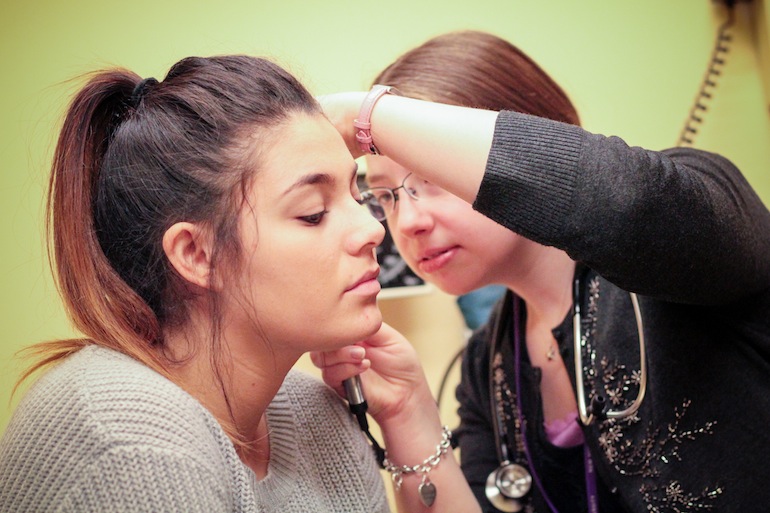At an Institute for Family Health center near Union Square in New York City, medical student Sara Stream asks a new patient named Alicia what brings her in. It’s been many years since the 34-year-old patient, who arrived last summer from Guatemala, has seen a doctor.
Her list of ailments is long.
“I have trouble seeing, headaches, problems with my stomach,” says Alicia, who declined to use her full name, because she is in the country illegally. “I feel depressed.”
Stream takes the problems one by one, carefully asking follow-up questions about when symptoms started, when they recur, where they’re felt, and what Alicia thinks the causes might be. Stream is using a translator, who also happens to be her supervisor, Dr. Amarilys Cortijo. As the symptoms pile up, Cortijo steps in.
“A lot of the symptoms she has are somatic,” says Cortijo. “We’ll have to deal with the complaints and try to get to the root, which is probably all the emotional turbulence that is taking place.”
Cortijo works for the Institute for Family Health and is co-director of two student free clinics — one the Institute runs in the Bronx with volunteer students from Albert Einstein College of Medicine and this one, downtown, which the Institute runs with volunteer students from New York University School of Medicine. Many other medical schools around the country run similar clinics that treat uninsured people for free. They typically meet once a week, taking in a few dozen patients per session, and treating several hundred patients over the course of a year.
The programs are among the most popular extracurricular activities at medical schools, and at some institutions almost all students volunteer at some point during their training.
Students do everything. First- and second-year students perform more administrative tasks, such as running the reception desk, coordinating lab tests and follow-up treatment and fund-raising. Third- and fourth-year students see patients, with faculty physicians overseeing all formal diagnoses and prescriptions.
At the NYU clinic, students increasingly have had to help drum up business. Many of the core patients in the Union Square area picked up Obamacare coverage, leading to a 25 percent decline in visits last year.
“A lot of our patients had been freelance people, who were the most likely to benefit from the changes in health coverage,” says Dr. Sarah Nosal, co-director of the program.
So NYU students have had to go out recruiting in a way they didn’t need to before, heading to churches and community centers in neighborhoods farther away, to let people like Alicia know about the free healthcare they could get if they come to the clinic.
“[The students have] reached out to communities where undocumented people were and made them aware of our resources,” Nosal says.
But these free clinics are not major venues for taking care of the uninsured. Most of the close to 2 million uninsured people in New York state and 1 million in the city get health care in emergency rooms, city hospitals or community health centers — if they get it at all.
Still, Dr. Neil Calman, head of the Institute for Family Health, said the clinics perform a valuable service for both patients and future physicians.
“This is an opportunity for medical students to get involved in the business end of seeing what health care is like for people who don’t have the same kind of access that they have to it,” he says. “It’s really a learning experience.”
Stream and Cortijo quickly realize Alicia has too many problems for student trainees to take on so Alicia will become Cortijo’s patient at one of her offices in Harlem or the Bronx.
That’s one less patient for the free clinic, though there are plenty of others in line behind her.
For Stream, there’s a satisfying difference between treating patients at the flagship NYU hospital and at the free clinic.
“Here, a patient may not have seen a doctor in the past 10 years. Patients may not have ever have seen a doctor,” she says. “While they’re here I want to figure out what’s wrong and how I can help them the most because we don’t know when they’re going to see a doctor again.”
Stream is in her last semester. After that, whether she keeps seeing uninsured patients will depend on where she does her residency and where sets up shop.








